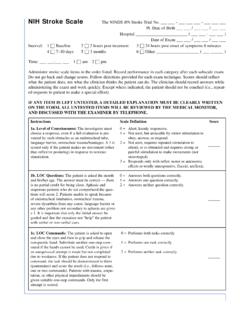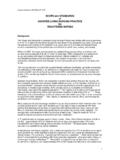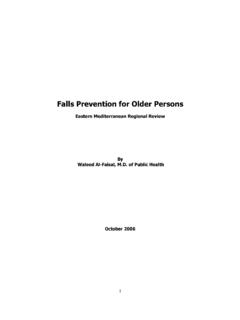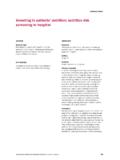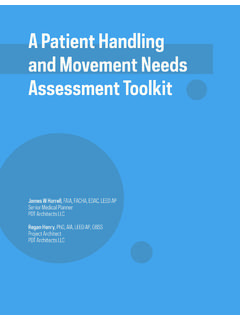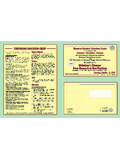Transcription of ED Transfer Communication - Illinois Critical Access ...
1 ED Transfer CommunicationUSING DATA TO DRIVE IMPROVEMENT!EDTC-4: Medication informationJune 16th2016 Presented By: Shanelle Van DykeAgenda EDTC 4 Measure Overview Review of Data Results Discussion amongst CAHs Review of EDTC 4 Abstraction Guidelines(If Necessary) Roles and Responsibilities Interpretation of EDTC 4 Reports (Q1 2016) Sharing of Best Practices Plan, Do, Study/Check, Act (PDSA/PDCA) Sample forms, checklists, fact sheets, etc. Additional resourcesMeasure 1:AdministrativeCommunicationEDTC 2: PatientInformationEDTC 3: Vital SignsEDTC 4: MedicationInformationEDTC 5: PractitionerInformationEDTC 6: NurseInformationEDTC 7: Proceduresand TestsAll EDTC MeasuresPerformance %WY CAH EDTC Results Q1 2015 -Q1 1:AdministrativeCommunicationEDTC 2: PatientInformationEDTC 3: Vital SignsEDTC 4: MedicationInformationEDTC 5: PractitionerInformationEDTC 6: NurseInformationEDTC 7: Proceduresand TestsAll EDTC MeasuresPerformance %WY CAH Aggregate EDTC Measure Results_Q3 2015-Q1 20016 Comparison3Q20154Q20151Q2016 Review of Data Results: Discussion amongst CAHs Insert notes form discussion & Documentation Encourage healthcare professionals to take personal responsibility for the Transfer of information about medicines.
2 Provide a common data set for the improvement and development of organizational systems and processes to support the safe Transfer of information about patients medicines. Engage with patients to encourage them to take an active role in understanding their medicines to improve their safe management when they move between care providers and healthcare & DocumentationFour core principles for health care care professionals transferring a patient should ensure that all necessary information about the patient s medicines is accurately recorded and transferred with the patient, and that responsibility for ongoing prescribing is taking over the care of a patient, the healthcare professional responsible should check that information about the patient s medicines has been accurately received, recorded and acted (or their parents, or advocates, or caregivers, etc.)
3 Should be encouraged to be active partners in managing their medicines when they move, and know in plain terms why, when and what medicines they are about patients medicines should be communicated in a way which is timely, clear, unambiguous and legible; ideally generated and/or transferred electronicallyCommunication & DocumentationThree key responsibilities for organizations providing organizations must ensure that they have safe systems that define roles and responsibilities within the organization, and ensure that healthcare professionals are supported to Transfer information about medicines should focus on improving patient safety and patient outcomes. Organizations should consistently monitor and audit how effectively they Transfer information about and poor practice in the Transfer of medicines should be shared to improve systems and encourage a safety Plays a RolePhysician Responsibilities: Write complete transition orders, including medications according to the facility s Medication Reconciliation process.
4 Nurse Responsibilities: Discuss new medications ordered with the patient/family. Arrange to have medication prescriptions filled. Complete any required teaching for continued treatments and medication at home and document on a Discharge Instructions form. Assure medication reconciliation is completePatient Responsibilities: Play an active role in understanding their medicines to improve their safe managementTips for Taking Medication HistoryUse a systematic approach For example, begin by asking about prescription medications, then over the counter products, and last vitamins/herbals/nutritional supplements or develop and implement a standardized process patients Explain the importance of carrying an updated medication list to share with all healthcare providers. Explain the importance of obtaining a complete and accurate medication yes/no questions Ask open ended questions to solicit additional information.
5 Review medical history inquire about commonly prescribed medications for health conditions for Taking Medication HistoryConsider all sources to obtain medication history and/or to clarify conflicting information, such as: Patient Patient s medication list ask when the list was last updated Caregiver/family member Prior care provider Community pharmacy Physician(s) Past medical recordsFor each medication, record: name, strength, dose, route, frequency, and last dose taken. *Note any discrepancies in prescribed medications vs. what the patient reports he/she is actually taking. SAMPLE QuestionsSAMPLE QuestionsED Transfer Comm. Data Collection ToolEDTC Report InterpretationHigh PerformerSharing of Best PracticesSharing of Best Practices RECOMMENDED TRANSITIONS OF CARE PRINCIPLES AND STANDARDS IMPROVE ACCOUNTABILTY IDENTIFY RESPONSIBILITY COORDINATE CARE INVOLVE FAMILY CLEARLY COMMUNICATE ASSURE TIMELINESS UTLIZE NATIONAL STANDARDS AND METRICS Improvement TechniquesPrinciples of Improving.
6 Know why you need to improve a system and/or process Have a way to obtain feedback to let you know if improvement is occurring Develop a change that you think will result in improvement Test a change before implementing Implement a changeShow Sample Medication Transfer Sheet(s)Sample ChecklistWhile some aspects of emergency department Transfer Communication may be unique, many of the Communication concepts and ideas that have been developed for transitions of care or handoffs between settings along the continuum of care also apply. Below is a series of sample checklists that can be used, adapted, or provide suggestions on how to meet your hospital s and community s unique needs. Safer Handoff: Patient Handoff Checklist. Emergency Nurses Association (ENA). Developed to highlight information that should be transferred to and from emergency departments and Long Term Care facilities/agencies.
7 Transfer Checklist and Feedback Form. Northeast Health Care Quality and feedback form for interfacilitytransfers. Allows receiving facility to provide feedback and suggestions if information was not received or is incomplete. Acute Care Transfer Document Checklist. Interact. Florida Atlantic University. Designed for long term care facilities to ensure appropriate documentation is sent with a resident to the Emergency Department. Could be adapted to address Communication from the emergency department to other settings of Transfer FormsTransfer forms are another tool used to improve Transfer communications. In some states, minimum data standards have been set for all care transitions/transfers. Examples of what is required within the standard data sets established for all care transitions include: Principle diagnosis and problem list Reconciled medication list including over the counter/herbals, allergies and drug interactions Clearly identified medical home/transferring coordinating physician/provider/institution and their contact information Patient s cognitive status Test results/pending results Pertinent discharge instructions Follow up appointments Prognosis and goals of care Advance directives, power of attorney, consent Preferences, priorities, goals and values, including care limiting treatment orders ( , DNR) or other end of life or palliative care plansSample Transfer FormsIn addition, the ideal Transfer record would also include.
8 Emergency plan and contact number and person, Treatment and diagnostic plan, Planned interventions, durable medical equipment, wound care, etc., Assessment of caregiver status, and Patients and/or their family/caregivers must receive, understand and be encouraged to participate in the development of their transitions record which should take into consideration the patient s health literacy, insurance status and be culturally sensitiveFollowing are sample Transfer forms that can be adapted to meet your hospital emergency department and community needs, including: Safer Handoff: Patient Handoff/ Transfer Form. Emergency Nurses Association (ENA). Universal Transfer Form. New Jersey Department of Health. Interact Hospital to Post Acute Care Transfer Form. Florida Atlantic University. Designed for acute care discharges to post acute facilities.
9 Could be adapted for emergency department use. Model Transfer Form: Nursing Facility to Emergency Department/Hospital. VirginiaDepartment of Health. Designed for nursing facility use, could be adapted or used as a tool with local nursing home Reminders Next Q2 2016 EDTC Data Submission Deadline is July 31st 2016 NEW! Quality Improvement Matters (QIM) website Quality Improvement Matters Newsletter: June version to go out the 17th MBQIP Deadline Reminders: Q1 2016 Outpatient Core Measures (AMI, CP, PM) due August 1st2016 Q1 2016 Inpatient Core Measures (IMM 2) due August 15th2016 Q1 2016 Inpatient & Outpatient Population & Sampling due August 1st2016 THANK YOU!Questions ? ? ?Shanelle Van Hoffman Wyoming FlexFlex-Office of Rural Spinarski Rural Health EHR Medication Profile SampleReview recommended core content of records for medicines when Patients Transfer care ProvidersAdditional Resources ( Nurse to Nurse Communication & Care Transitions) Appropriate InterhospitalPatient Transfer .
10 American College of Emergency Physicians. This website includes policy statements and principles regarding patient transfers. Care Transitions Program. Dr. Eric Coleman. This website includes tools and resources to support care transitions, including those with Spanish and Russian translations. Care Transitions: Strengthening Communication , Improving Outcomes. Oregon PatientSafety Commission. Retrieved January 1, 2014. This website discusses care transitions between various health care settings and presents tools and resources to support improvements. Got Transition. Center for Health Care Transition Improvement. This toolkit focuses specifically on transitions related to young adults and children with special needs. It includes policies and procedures, action plans, and checklists. Critical Care in the Emergency Department: Patient Transfer .
